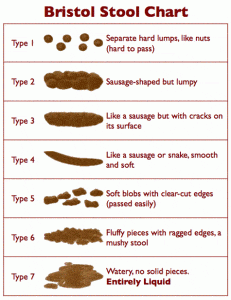Childhood constipation is common. The prevalence of childhood constipation has been estimated at somewhere between 4 and 36% (that’s one in three kids with constipation!). Constipation accounts for 3% of childhood hospital admissions and 25% of referrals to paediatric gastroenterologists.
What Is Constipation?
Although many people seem to think that constipation is defined by how frequently a person passes stool, this is not the most important factor. More important is what it looks like (and feels like) when it comes out. A child may pass tiny hard pellets several times per day- this is obviously not good.
An ideal stool looks like a sausage- long and smooth, with no lumps or cracks on the surface. This is a “type 4” stool on the Bristol stool chart, which we often use to describe the appearance of stool.

Bristol Stool Chart
A type 1 stool is associated with quite severe constipation, and even a type 2 or 3 stool may be associated with pain and straining, and possibly some abdominal discomfort. Strangely, type 6 and 7 stools can sometimes be associated with severe consitpation: it is possible for the bowel to become so loaded with hard stool that only watery stool is able to bypass the obstruction, giving the appearance of diarrhoea.
What Causes Constipation?
Children can become constipated for a number of reasons. Often, the trigger can be toilet training. Some children find “pooping in the potty” a frightening experience and hold on to their poop (a practice doctors call “stool holding”). Unfortunately, the situation is then exacerbated by the child finally passing a very large and hard stool, which can be very painful; this then reinforces the fear of passing stool, and the cycle continues.
Starting school can also be a trigger; children are encouraged not to go to the bathroom during class time. Some children learn to stool-hold and ignore the urge to go to the toilet. Children may dislike passing stool in school, preferring to hold onto it until they get home.
Diet can play a part in the evolution of constipation: children who eat less fruit and vegetables are at increased risk of constipation. Too much fibre in a child’s diet without adequate fluid intake can also lead to consitpation.
Children who drink too little water are more likely to be constipated, which is often a problem in tropical countries such as Singapore, where children sweat more, and need to drink even more to stay well hydrated. Most children (and most adults) do not drink enough fluids. An average 12kg two year old child who takes around 500ml of milk per day needs approximately 500-600ml of water every day for adequate hydration.
What are the signs of constipation?
- Straining and difficulty in passing stool
- Small and hard stools (although some children may pass exceptionally large and hard stools)
- Stool holding: your child may actively suppress the urge to pass stool due to fear of the pain associated with it
- Abdominal pain
- Bloating and frequent passing of gas
- Reduced food intake, and a sensation of fullness
- Vomiting: if your child vomits due to constipation, you should seek medical attention urgently
What Can You Do?
- You should make sure your child is drinking enough fluids. An infant under 12 months requires between 600-1000ml; a toddler needs around 1-1.5 litres. A child above the age of five years needs more than 1.5 litres, depending on their size and physical activity)
- Ensure your child is eating sufficient fruits and vegetables: your child should have around two half cup portions of fruits and two half cup portions of vegetables. For more help with feeding a picky toddler, see https://www.doctor-natalie.com/tag/feeding-a-picky-toddler/
- Encourage your child to sit on the toilet for ten minutes after a meal. You can also ask him to sit on the toilet when you see him showing signs of stool holding. You can offer to read him a story to encourage him to stay for longer, or rub his tummy if he is hurting.
- Try reducing foods that predispose to constipation, such as eggs, banana and avocado. Instead, try giving prunes, apricots, papaya and red dragon fruit, all known for their ability to move mountains!
Medications:

How Laxatives work
- Osmotic Laxatives, such as Lactulose: a non-absorbable sugar. This medication stays within the bowel and is not absorbed by the body. It acts by a process called “osmosis”, actively pulling water through the wall of the bowel to soften the stool, making it easier to pass out.
- Polyethylene Glycols: This group of medications includes Movicol, Mirolax and Forlax. They also act primarily by osmosis, causing the stool to become more soft. Care needs to be taken when using osmotic laxatives to ensure that the child takes enough fluids.
- Glycerin Suppository: this can be useful in small children if the stool is impacted and cannot come out.
- Enemas: you should consult a doctor before using an enema in a young child. Your doctor may use these to disimpact hard stool that cannot come out with osmotic laxatives alone.
- Stimulant Laxatives, such as Senna: these are rarely used in young children as they tend to increase pain and discomfort. Young children are at risk of stool holding in respond to pain and discomfort; medications that increase fear surrounding passing stool should be used only as a last resort, and only under the supervision of a paediatric gastroenterologist.
Remember that children will often need to stay on medication for a long period of time to allow the bowel to return to its normal size, and learn how to function properly again. A good rule of thumb is to think how long your child has been suffering with constipation: if it is only a couple of weeks, then you may only need to treat for a week or two. However, if the problem has been going to for several months, treatment may last several months too.
Has your child suffered with constipation? What did you find helpful? Leave your comments in the box below. And remember to subscribe to receive weekly medical and parenting information direct to your inbox. Have a great week ahead.

4 Comments
Great article, very useful.
My son, 3 years, has suffered with constipation althought he drink enough water per day and eat vegetables.
This article is very interesting in explaning how a frightening feel may play in this.
Looking forward for more article like this. Thanks once again.
You are most welcome
That is very great article. I got a daughter who has big stool and hard to pass it out since she was 2.5 or 3 years old. I’m not sure what caused such constipation. I just get her to meet doctor. As a result, doctor said she has constipation type 2 or 1. Doctor ask to have medication by giving her liquid medicine to make her stool soft & probiotic for a month. Could I ask if it is the right treatment ? Is the constipation impact to kid development ? Because my kid is small comparing to kid at her age. But, doctor said she is normal.
Hi Sothea,
Certainly using a stool softener can help, but it is important to ensure she is also drinking enough water. Take a look at her fruit and vegetable intake as well- two half- cup portions of each every day should be sufficient.
Some children who are very constipated find it difficult to eat large meals as they already feel “full”, so they don’t eat as much as they should. Hopefully, once the stool is nice and soft, and easy to pass, her appetite should improve.